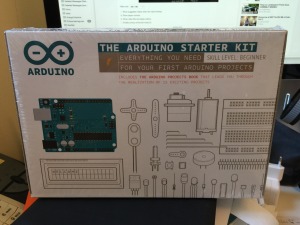Even more interesting than the demos though was the IoT hacking area. In this area, SAP staff worked to create interesting Internet of Things connected devices, and there were machines available with Arduino, Tessel, and Beaglebone microcontrollers and instructions on how to connect them to sensors, pull data from the sensors, and push that data up to the Hana Cloud Platform.
In the Las Vegas event the SAP staff created the scarecrow seen in the video above. This scarecrow would flash the LEDs in its eyes, move its head, move its arms, and fire a Nerf gun when commanded to do so over Twitter. In the slo-mo video above, it does all the actions at once. Apologies for the quality of the video, it was shot using a smartphone lying prone on the floor.
We spoke to SAP’s Craig Cmehil subsequently to get hints on how to start out learning about hacking Internet of Things projects at home and he supplied us with a list of resources.
Craig recommended getting started with one of the following kits:
For Arduino
- SainSmart UNO R3 Starter Kit With 19 Basic Arduino Tutorial Projects
- Proto-PIC Boffin Kit for Arduino UNO
- SunFounder Project Starter Kit For Arduino UNO R3 Mega2560 Mega328 Nano
- or Arduino’s own Arduino Starter kit (pictured below)
While for Raspberry Pi there’s
- SunFounder 37 modules Raspberry Pi Sensor Kit, 26-Pin GPIO Extension Board GPIO Cable Jump wires
- SunFounder LCD Ultrasonic Relay Sensor Electronic Bricks Starter Kit w/ 26-Pin GPIO Extension Board GPIO Cable, 1602 LCD, Breadboard, Jumper wires, Servo Motor, Relay, Resistors, Buzzer for Raspberry Pi
- Sunfounder Project Super Starter Kit w/ T-Cobbler, GPIO Cable, H-Bridge L293D, ADXL335, DC Motor, 7-Segment, Dot Matrix Display for Raspberry Pi
The links above are direct links to these items on Amazon, and there are many more accessories available on the Sparkfun site.
Not sure what the differences are between an Arduino and a Raspberry Pi? Check out this great explainer on Read Write Web.
Now, having decided on your IoT platform, what about some good resources, well,
- if you are planning to include your kids in the process, then Raspberry Pi kid is a good blog to check out
- Coder for Raspberry Pi is an open source project to teach kids how to build websites using the Raspberry Pi
- Adafruit has some great lessons on coding for Raspberry Pi, like this one for temperature sensing
- Adafruit also has lots for Arduino
- The Arduino site has lots of resources available for all levels of learner
And if you are wondering about connecting these devices to the cloud, Rui Nogueira has a great two piece blog post with detailed instructions for Raspberry Pi here.
If hacking microcontrollers is your thing, or you think it could be, then our ThingMonk event next week in the UK is the place to be. It is a three day event with day one being hacking, day two is IoT tech talks, and day three (called Business of IoT) is business related IoT talks.

